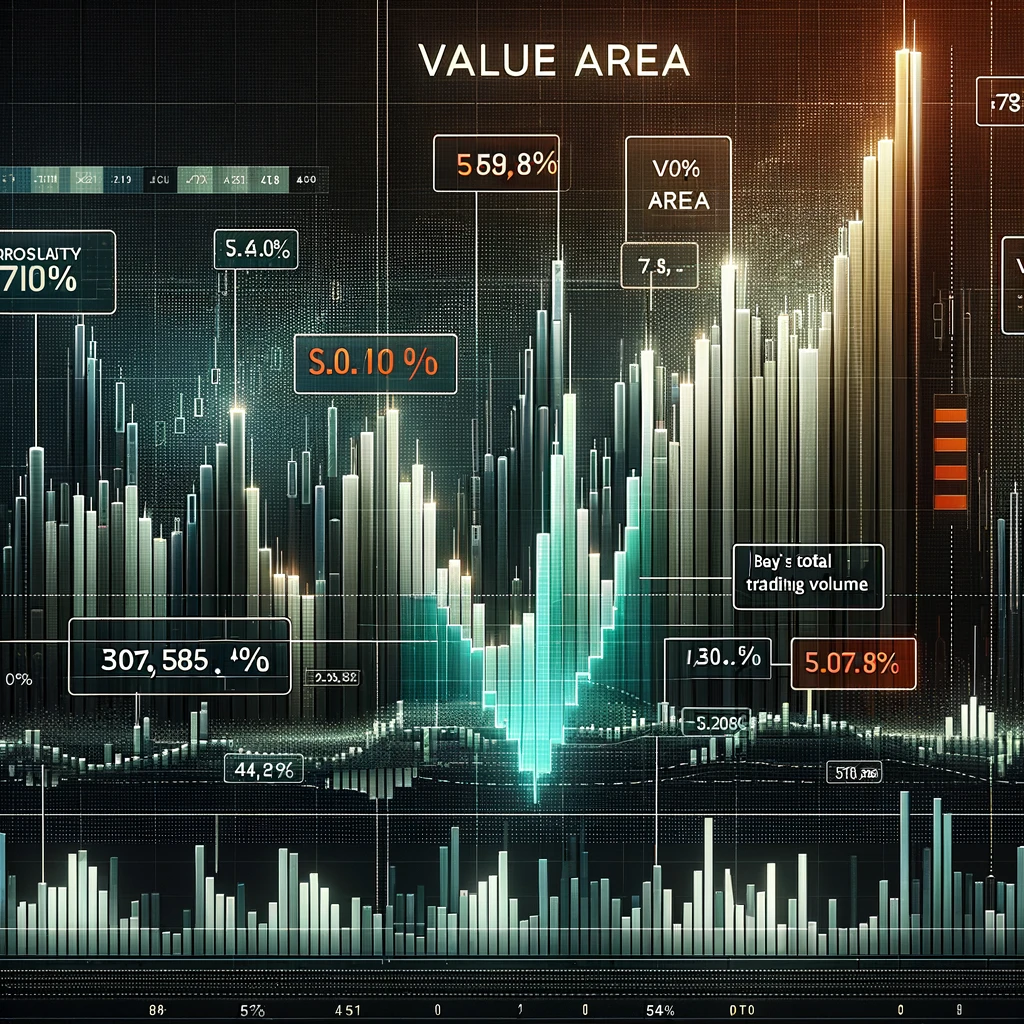Regardless of your timeframe, the key to trading success is understanding price action. If the goal is to “buy low, sell high,” a trader needs to understand when price is more likely to move in one direction or another.
Value area is a one market facet used by traders to identify areas of interest on a price chart, and help predict how price is likely to react.
Value Area Defined
Value area refers to the price range where a significant portion of trading volume has occurred over a specified time period. This typically means 70% of the previous day’s total trades. (It is derived from the market profile, a statistical tool that traders use to evaluate market activity and liquidity.)
For example, on the S&P 500 futures market, 70% of the trading volume from the prior day may have taken place between the prices 5217.75 and 5236.25. The lower end of this range would be deemed “value area low” (VAL), while the higher price would be “value area high” (VAH).
The single price level with the greatest traded volume is called the “point of control” (POC). This price will generally be within the range between VAL and VAH, but it doesn’t have to be.
By identifying the value area, traders gain insight into the levels at which the market deems price to be fair, indicating where buyers and sellers are most active.
Understanding the value area is vital for day traders, as it reveals key insights into price action and market sentiment. It highlights where the majority of trading activity happens, offering clues about potential support and resistance levels. This knowledge is indispensable for making educated trading decisions, especially in the fast-paced realm of day trading.
Applying the Value Area to Day Trading
1. Identifying Market Trends: The position of the current price in relation to the value area can signal the market’s direction. If the price is above the value area, it suggests bullish sentiment, while a price below indicates bearish trends. Day traders can use this information to align their trades with the prevailing market momentum.
2. Spotting Potential Reversals: Changes in the value area from one day to the next can hint at upcoming market reversals. For instance, if the value area shifts significantly higher or lower without a corresponding move in price, it may signal that a reversal is on the horizon. Savvy day traders keep an eye on these shifts to anticipate and capitalize on potential market movements.
3. Setting Entry and Exit Points: The value area provides a benchmark for establishing entry and exit points. Traders might consider entering trades near the edges of the value area, where price is more likely to revert back to the mean. Conversely, exiting a position when the price moves outside the value area can help lock in profits or cut losses, as such movements may indicate a stronger trend developing.
80% rule
The 80% rule is one of the more popular ways traders invoke and use value area to inform trades. This rule provides a strategy for predicting and capitalizing on potential market movements based on the initial behavior of the price relative to the value area. It’s a favored technique among day traders for its simplicity and effectiveness in identifying high-probability trading opportunities.
For a detailed explanation of this rule and how to use it in your trading, see What Is The 80% Rule?
Maximizing Profits with the Value Area
The ability to interpret and utilize the value area in day trading cannot be overstated. It offers a window into where the majority of trading activity occurs, allowing traders to position themselves favorably within the market’s ebb and flow. By integrating value area analysis into your trading strategy, you can:
- Enhance your understanding of market dynamics
- Improve the timing of your trades for better entry and exit points
- Increase your chances of executing profitable trades
Incorporating the value area into your day trading toolkit can provide a significant edge in navigating the markets. It empowers day traders with the ability to decipher market sentiment, anticipate price movements, and make strategic decisions that align with their financial goals.
Types of Day Trading Using Value Area
-
Range Trading: Day traders often employ range trading strategies, buying near the lower end of the value area and selling near the upper end. This strategy capitalizes on the tendency of price to revert to the mean within the value area.
-
Breakout Trading: Breakout traders look for opportunities when price breaches the boundaries of the value area. These breakouts can signal the beginning of a new trend, allowing traders to enter positions early and ride the momentum for profits.
-
Volume Analysis: By combining volume analysis with the value area, traders can identify significant levels of buying or selling pressure within the value area. Unusual volume spikes or divergence from normal volume patterns can provide valuable signals for potential price reversals or continuations.
-
Confirmation of Support and Resistance Levels: The value area can act as a confirmation tool for identifying key support and resistance levels. Prices frequently respect the boundaries of the value area, making it a reliable reference point for setting stop-loss orders or profit targets.
Conclusion
For day traders looking to elevate their trading game and unlock the secrets to making money through astute market analysis, mastering the value area is essential. It not only enriches your understanding of price action but also opens up new avenues for profit-making. Remember, the key to successful day trading lies in continuous learning and adapting to market changes. By leveraging the insights provided by the value area, you’re one step closer to achieving your trading aspirations and financial independence.
Keep exploring, stay informed, and may your day trading journey be prosperous and rewarding!
Risk Disclosure:
Futures and Forex trading contains substantial risk and is not for every investor. An investor could potentially lose all or more than the initial investment. Risk capital is money that can be lost without jeopardizing one’s financial security or lifestyle. Only risk capital should be used for trading and only those with sufficient risk capital should consider trading. Past performance is not necessarily indicative of future results.
Hypothetical Performance Disclosure:
Hypothetical performance results have many inherent limitations, some of which are described below. No representation is being made that any account will or is likely to achieve profits or losses similar to those shown. In fact, there are frequently sharp differences between hypothetical performance results and the actual results subsequently achieved by any particular trading program. One of the limitations of hypothetical performance results is that they are generally prepared with the benefit of hindsight. In addition, hypothetical trading does not involve financial risk, and no hypothetical trading record can completely account for the impact of financial risk of actual trading. For example, the ability to withstand losses or to adhere to a particular trading program in spite of trading losses are material points, which can also adversely affect actual trading results. There are numerous other factors related to the markets in general or to the implementation of any specific trading program, which cannot be fully accounted for in the preparation of hypothetical performance results and all of which can adversely affect trading results.
Any testimonials appearing on this website may not be representative of other clients or customers and is not a guarantee of future performance or success.
Affiliate Disclosure:
The external links on this site and in video descriptions to third party companies are often affiliate links. We may earn a commission from these companies on any sale made from people visiting these links. That said, we only list companies and software we personally do recommend.
Additional Disclosure:
The content provided is for informational purposes only. We do our best to keep the content current and accurate by updating it frequently. Sometimes the actual data, rules, requirements and other can differ from what’s stated on our website. Blackbelttrades.com is an independent website. You should always consult the rules, FAQs, knowledge base and support of any of the websites and companies we link to or talk about on our site. The information on their site will always be what ultimately dictates the current rules of their program, software or other. While we are independent, we may be compensated for advertisements, sponsored products, or when you click on a link on our website. The contributors and authors are not registered or certified financial advisors. You should consult a financial professional before making any financial decisions.




